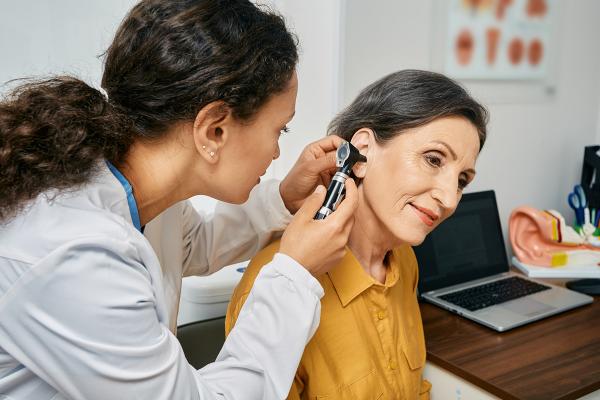
EPIC Hearing Healthcare helps members access hearing exams, hearing aids and more. Sign in to learn more and check eligibility.
Learn expert ways to clean and store your hearing devices, no matter which type you have.

No one needs to tell you how priceless hearing aids are. They help keep you connected to the world by making some sounds louder.1 They may make it easier to hear conversations, enjoy music, and listen to that funny video your friend sent you.
That’s why it’s important to take care of your hearing aids. First, you want to keep on hearing well. And it’s hard to do that if the devices get damaged by earwax and other grime.2 Second, earwax and other debris — such as skin cells, sweat and dust — may build up on the eardrum. This could lead to infections and irritation.
The best way to maintain your hearing aids is to get into a cleaning routine, says Sara Lerner, Au.D. She’s the director of clinical audiology at ENT and Allergy Associates of New York and New Jersey. “That helps them keep working long-term,” she explains.

EPIC Hearing Healthcare helps members access hearing exams, hearing aids and more. Sign in to learn more and check eligibility.
Here is what Lerner and other experts recommend doing, step-by-step, to clean and care for your hearing aids each evening.
Step 1: Take them out. Hearing aids are meant for daytime use.3 That means you need to remove them from your ears every night before bedtime, clean them and store them. It’s a good idea to get into a nightly routine, just as you do with brushing your teeth and washing your face.
Step 2: Wipe them down. “Clean off any moisture, debris or wax that you might see on them,” says Lerner. Do this every night with a dry cloth or even a tissue, she adds. Microfiber or other soft cloths work well.
Just remember to use a dry cloth. “You should not use any water or spray anything wet on your hearing aids,” warns Lerner. And don’t use wet wipes either.
If your hearing aids are battery-operated, this would also be a good time to check the battery compartment and see if your batteries need replacing.2
Step 3: Use a brush. Remove any stubborn earwax or debris with a small, soft brush. Your hearing care professional may have given you a kit that includes a brush and other cleaning tools.4 Or you can use an old soft toothbrush to brush off grime and wax, notes Lerner.
Check the wax guard too. “Most hearing aids have a wax guard that covers the receiver where the sound comes out,” Lerner explains. The wax guard does what its name says — it protects the receiver from earwax. It can be wiped down. But if there is too much earwax, it may have to be changed. (More on that below.)
Step 4: Pop your hearing aids into a case or charger. If your hearing aids run on disposable batteries, “I recommend putting your hearing aids into a case as a way not to lose them,” says Lerner. Be sure to open the battery door to turn off the hearing aids and save battery power. Of course, many hearing aids come with rechargeable batteries. In that case, you need to put them in their charger, she adds.
Step 5: Keep them dry. After you’ve stored your hearing aids, keep them in a dry place. “Not the bathroom,” warns Lerner, which is often warm and humid.
“Your audiologist might recommend a dehumidifier as well, depending on where you live or how much you perspire,” she adds. Some charging units come with a special compartment and capsules for overnight drying. Or buy a dry-aid kit. Your hearing care professional can suggest some options.
The receiver of your hearing aid (where the sound comes out) is usually protected by a wax guard. When the wax guard becomes clogged with wax, take out the old one and replace it with a new one. Hearing aids usually come with a supply of wax guards that you can use to replace them yourself. You may also be able to get new wax guards from your hearing care professional, says Lerner.
How often should you change it? “Every audiologist will have their own recommendation,” says Lerner. “My rule of thumb is once a month, if you’re not noticing issues sooner.” Any time the hearing aid sounds weak or dead, you should change the wax guard and see if that fixes the issue, she adds.
You may also need to change it more frequently, depending on how much earwax you produce, notes Lerner. Some people produce more than others — and wearing hearing aids can stimulate earwax production too.5
Cleaning your hearing aids daily will keep them in good shape. But they do need a thorough professional cleaning too.
“We recommend following up with a hearing care provider every 6 months or so, just to get a general check to make sure everything’s working properly,” says Lerner. You may need to go even more often, especially if you’re having trouble with your hearing aids or have too much earwax buildup. Pro cleanings may even be covered depending on your hearing plan’s benefits.
Ask your hearing care professional about the right cleaning schedule for you. They might also show you tips for keeping your hearing aids clean, before you take them home.
If you have over-the-counter hearing aids, the manufacturer may have online videos that show you the best way to clean and care for your devices. Most OTC hearing aids come with some tools for cleaning them, too, like brushes and cleaning cloths.
Did you know that many hearing benefits, including a hearing exam and consultation, are covered through EPIC Hearing Healthcare? Learn more.
Sources
Information is for educational purposes only and is not a substitute for the advice of a licensed medical provider. Consult your provider prior to making changes to your lifestyle or health care routine.